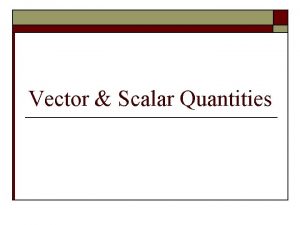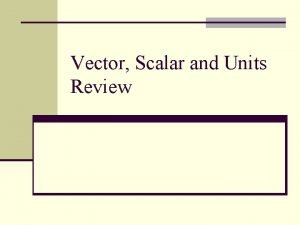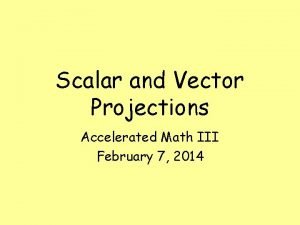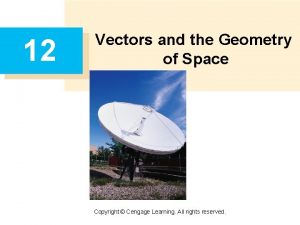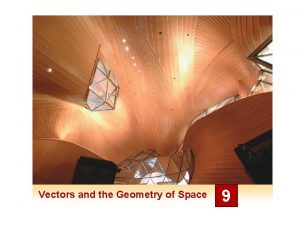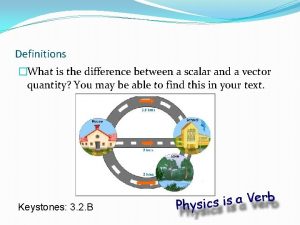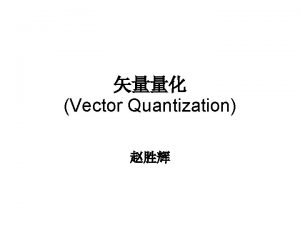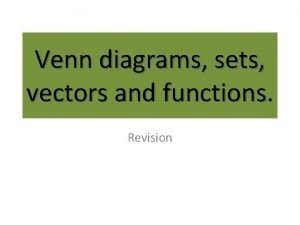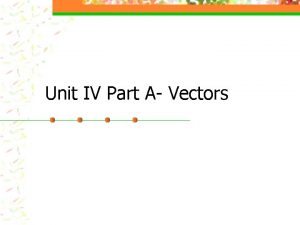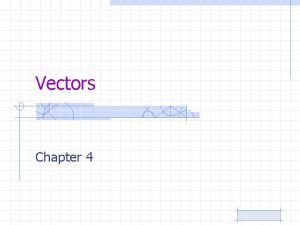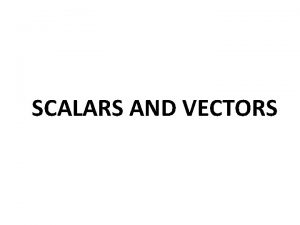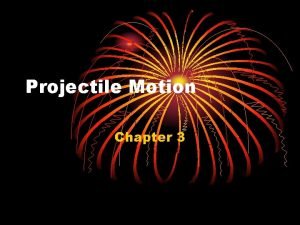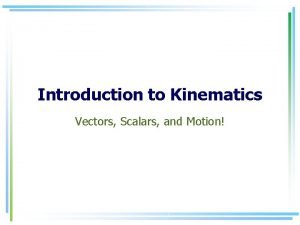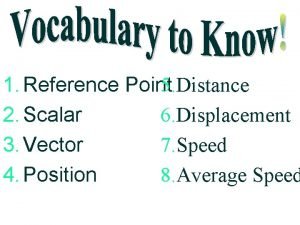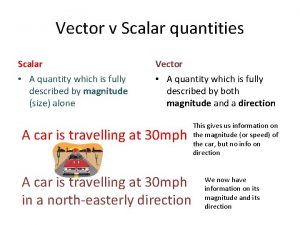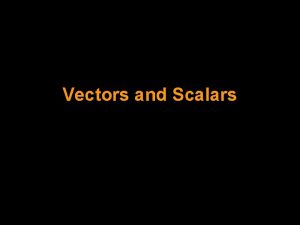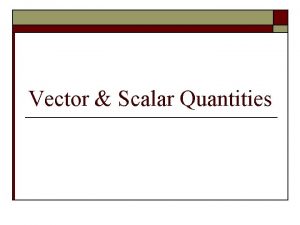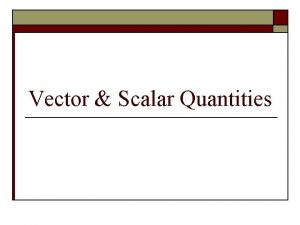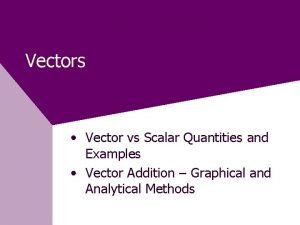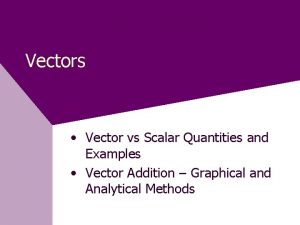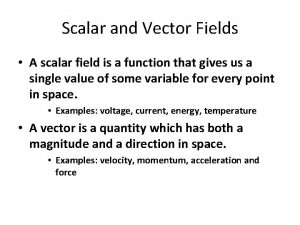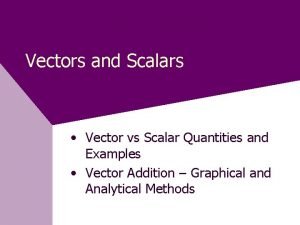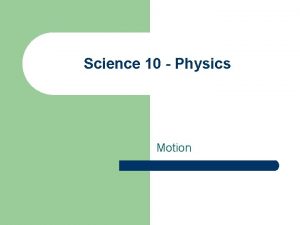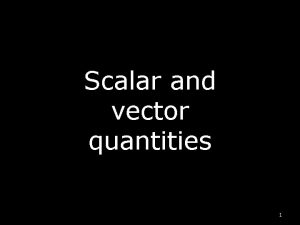Vector and Scalar Quantities 73 77 72 71


























- Slides: 26

Vector and Scalar Quantities 73 77 72 71 82 84 83 88 75 68 64 80 73 57 56 55 66 88 75 80 90 83 92 91 77 • Scalar has only amplitude, e. g. the temperature • Vector has both amplitude and direction, e. g. the wind 1/7/2011 1

We need clear, precise definitions of various physical quantities In order to describe a physics process • Some are used frequently in daily life (Speed) • Some are not (velocity, acceleration) What’s the difference between: Øaverage speed and instantaneous speed? Øspeed and velocity? Øspeed and acceleration? 1/7/2011 2

Units System • There are many systems of units • For this class we use the SI system (International System of Units). SI Length – hand, foot, mile, … meter Time – sundial, water clock, second Mass – pound, ton, gram… kilogram Volume – peck, bushel, cup … cubic meter Area - acre, square mile, hectare square meter • When solving problems, use the same system for different quantities. Then covert it to any other systems at the end. • 1/7/2011 3

A floating dog http: //www. digitaljournal. com/image/71076 https: //www. youtube. com/watch? v=6 Nv. BGb 5 lf 78 4

To summarize the car’s velocity information, let the horizontal axis represent time, and the vertical axis represent velocity. §The velocity is constant wherever the slope of the distance-vs-time graph is constant. §The velocity changes only when the distance graph’s slope changes. 5

For example: a car traveling on a local highway §A steep slope indicates a rapid change in velocity (or speed), and thus a large acceleration. §A horizontal line has zero slope and represents zero acceleration. 6

7

In the graph shown, is the velocity constant for any time interval? a) b) c) d) e) Yes, between 0 s and 2 s. Yes, between 2 s and 4 s. Yes, between 4 s and 8 s. Yes, between 0 s and 8 s. No, never. The velocity is a constant value between 0 s and 2 s. The velocity is not changing during this interval, so the graph has a zero (flat) slope. 8

A car moves along a straight road as shown. Does it ever go backward? a) b) c) d) Yes, between 0 s and 2 s. Yes, between 2 s and 4 s. Yes, between 4 s and 6 s. No, never. Although the velocity is decreasing between 4 s and 6 s, the velocity is still in the same direction (it is not negative), so the car is not moving backward. 9

How long a distance did this car go? V(m/s) 6. 0 0. 0 10. 0 t(sec) The total distance 6. 0 m/s X 10 s = 60 m 10

How long a distance did this car go? V(m/s) 6. 0 0. 0 10. 0 t(sec) In each slice, velocity is ~ constant. Add all slice up, one have the total distance The total distance is the area covered by the velocity. vs. time graph. 11

During which time interval is the distance traveled by the car the greatest? a) b) c) d) Between 0 s and 2 s. Between 2 s and 4 s. Between 4 s and 6 s. It is the same for all time intervals. The distance traveled is greatest when the area under the velocity curve is greatest. This occurs between 2 s and 4 s, when the velocity is constant and a maximum. 12

Acceleration is the rate at which velocity changes, i. e. Acceleration = Δv/Δt – Unit is: length/(time x time), or meter/second 2 (SI) – Our bodies don’t feel velocity, if the velocity is constant. – Our bodies feel acceleration. • Feel the difference inside an airplane when it’s landing and up in air cruising. • Acceleration can be either a change in the object’s speed or direction of motion. • Acceleration is also a vector quantity, with magnitude and direction. – Acceleration is positive when velocity increase. • airplane departure – It is negative when velocity decrease. • airplane landing 13

Acceleration (cont. ) – The direction of the acceleration vector is that of the change in velocity, ∆v. – If velocity is increasing, the acceleration is in the same direction as the velocity. – If velocity is decreasing, the acceleration is in the opposite direction as the velocity. 14

Average and Instantaneous Acceleration A car starting from rest, accelerates to a velocity of 20 m/s due east in a time of 5 s. 15

Straight line motion with constant acceleration Quantify the relation among distance (d), velocity (v), acceleration (a) and time (t) a = Δv/ Δt = (v-v 0)/(t-t 0). Set t 0 = 0. v = v 0 + at d is the area of the right plot. Sum of large Number of Slices at all instant. d = v 0 t + ½*Δv t since a = Δv/ Δt d = v 0 t + ½*at 2 16

Vector Addition Vector addition: “tail to head technique” • Draw 1 st vector to scale. • Draw 2 nd vector by placing its tail at the head of the first vector • draw another vector from the tail of the 1 st vector to the head of the 2 nd one. • i. e. addition of two vectors. For addition any number of vectors. • Draw the succeeding vector by placing its tail at the head of the previous vector • Repeat this process until all vector are drawn • Draw the vector sum from the tail of the 1 st vector to the head of the last one. 17

Vector Subtraction B A C C A A B 18

Constant Speed Circular Motion q. The direction of the acceleration vector is that of the change in velocity, ∆v = V 2 V 1. -V 1 q. The acceleration • at right angles to the velocity at any instant. • point to the center of the circle. -V 1 V 2 19

- Ch 2 CP 4 d + x v 0 = 14 m/s a = 2 m/s 2 v = 24 m/s What is the time? What is the distance? Computed at 1 second intervals. ? a) v = v 0 + at, 24 m/s = 14 m/s +2 m/s 2 × t, t = 5 s b) d = v 0 t + ½ at 2 = 14 m/s × 5 s + 0. 5 × 2 m/s 2 × 5 s = 95 m c) 1 sec = 15 2 sec = 32 3 sec = 51 m 4 sec = 72 20

What is the average acceleration between 4 s and 8 s? . a) b) c) d) e) 1. 0 m/s 2 2. 0 m/s 2 1. 0 m/s 2. 0 m/s Impossible to determine 21

In the graph shown, during which time interval is the acceleration greatest? a) b) c) d) Between 0 s and 2 s. Between 2 s and 4 s. Between 4 s and 8 s. The acceleration does not change. The acceleration is greatest between 2 s and 4 s. The velocity is changing fastest, and the graph has the greatest slope, during this interval. 22

At which part the direction of the acceleration is opposite to that of velocity? a) b) c) d) Part A Part B Part C The acceleration does not change. 23

The velocity graph of an object is shown. Is the acceleration of the object constant? a) b) c) Yes. No. It is impossible to determine from this graph. The slope of the velocity curve gradually decreases with time, so the acceleration is decreasing. Initially the velocity is changing quite rapidly, but as time goes on the velocity reaches a maximum value and then stays constant. 24

The velocity graph of an object is shown. Is the acceleration of the object constant? a) b) c) Yes. No. It is impossible to determine from this graph. 25

Test Quiz: What is the average acceleration between 0 s and 4 s? . a) b) c) d) e) 1. 0 m/s 2 2. 0 m/s 2 1. 0 m/s 2. 0 m/s Impossible to determine 26
 Scalar vs vector difference
Scalar vs vector difference Vector and scalar quantities
Vector and scalar quantities Quantity with only magnitude
Quantity with only magnitude Scalar characteristics
Scalar characteristics Scalar vs vector
Scalar vs vector Vector versus scalar
Vector versus scalar Linear quantities
Linear quantities 5m vector or scalar
5m vector or scalar Scalar projection vs vector projection
Scalar projection vs vector projection Dot product
Dot product Vectors and the geometry of space
Vectors and the geometry of space Scalar and vector quantity difference
Scalar and vector quantity difference Scalar quantity
Scalar quantity Scalar and vector quantization
Scalar and vector quantization Scalar and vector venn diagram
Scalar and vector venn diagram Physical quantities units and measurement
Physical quantities units and measurement Which of the following is a pair of vector quantities
Which of the following is a pair of vector quantities 30 examples of vector quantities
30 examples of vector quantities Vector vs scalar
Vector vs scalar Scalar vector tensor
Scalar vector tensor Entropy is scalar or vector
Entropy is scalar or vector Is projectile
Is projectile Angular displacement scalar or vector
Angular displacement scalar or vector Vector vs scalar
Vector vs scalar Moment of couple is scalar or vector
Moment of couple is scalar or vector Centripetal acceleration is a scalar quantity.
Centripetal acceleration is a scalar quantity. Angular displacement is vector or scalar
Angular displacement is vector or scalar



